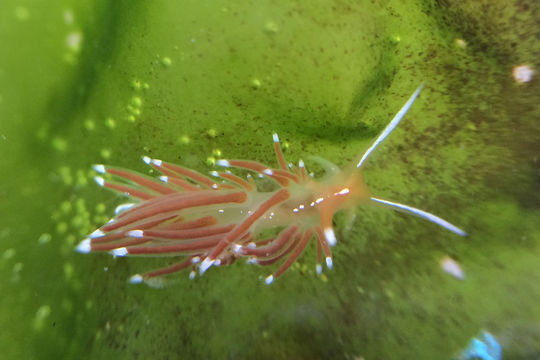Invasion History
First Non-native North American Tidal Record: 1972First Non-native West Coast Tidal Record: 1972
First Non-native East/Gulf Coast Tidal Record:
General Invasion History:
Sakuraeolis enosimensis is native to the Northwest Pacific from Mutsu Bay, Japan, south along both Japanese coasts to Korea, China and Hong Kong (Baba and Hamatani 1965; Rudman 2001). In 1972, it was first collected in San Francisco Bay. It is common in the South and Central Bay, but does not occur elsewhere on the West Coast (Behrens 1982; Behrens 1991; Cohen et al. 2005; Cohen and Chapman 2005).
North American Invasion History:
Invasion History on the West Coast:
In 1972, Sakuraeolis enosimensis was collected on marina floats in Pete's Harbor, Redwood City, California. It was associated with colonies of the bryozoans Bugula neritina and Ectopleura crocea, and the hydroid Obelia spp. (Behrens 1982). It has also been reported from San Mateo Bridge Pylons, and from a buoy in the Central Bay. Sakuraeolis enosimensis was most likely introduced with ship fouling or ballast water (Cohen et al. 2005; Cohen and Chapman 2005).
Description
Sakuraeolis enosimensis has a long, slender body, with the tail forming about 1/4 of the body length. Its oral tentacles are long, slender and tapering. The anterior corners of the foot are extended to form horn-like projections. The rhinophores are smooth and shorter than the oral tentacles. The cerata rise from 6-8 arch-shaped pads, in 2-3 rows, except for the posterior two arches, which bear a single row of cerata. The cerata are simple, smooth, and dense, with the longest, in the mid-dorsal region, reaching up to one-half the body length. The animal can reach 45 mm in length, but is more usually 25-30 mm. The color is highly variable, but the basic color of the body is translucent yellow. Sometimes, there are yellow-orange speckles on the head. The liver and its branches usually range from yellow-orange to reddish-brown, but can sometimes be green. The oral tentacles and the tail are marked with an opaque white mid-line, while the rhinophores and cerata have white tips, and the head is also speckled with white. Description based on Baba and Hamatani (1965), Behrens (1982), Behrens (1991), and (Rudman 2001).
Taxonomy
Taxonomic Tree
| Kingdom: | Animalia | |
| Phylum: | Mollusca | |
| Class: | Gastropoda | |
| Subclass: | Opisthobranchia | |
| Order: | Nudibranchia | |
| Family: | Facelinidae | |
| Genus: | Sakuraeolis | |
| Species: | enosimensis |
Synonyms
Cuthona (Hervia) ceylonica (Baba, 1935)
Hervia ceylonica (Baba, 1933)
Godiva ceylonica (Baba, 1955)
Dondice ceylonica (Abe, 1964)
Potentially Misidentified Species
Ecology
General:
Sakuraeolis enosimensis is a nudibranch found in harbors, and sheltered coastal regions. Nudibranchs are simultaneous hermaphrodites, and copulate reciprocally or unilaterally. Sakuraeolis enosimensis usually lays its eggs in a tightly coiled spiral, but sometimes as a mass of irregular and segmented strings. Most Northeast Pacific nudibranchs hatch out as planktotrophic larvae, but some have lecithotrophic larvae (Barnes 1983; Behrens 1984; Goddard 2007).
Sakuraeolis enosimensis is found in harbors and sheltered locations warm-temperate regions. In San Francisco Bay, it occurs on dock floats, buoys, bridge pylons, and other fouled strutures . It has been found repeatedly on the introduced hydroid Ectopleura crocea (Behrens 1984; Behrens 2004, in Miller 2014), but the range of its diet is not known. In many nudibranchs which feed on cnidarians, the nematocysts (stinging cells) are ingested, and are then incorporated into the cerata, as a defensive mechanism (Barnes 1983). This is probably the case in Sakuraeolis enosimensis.
Food:
Ectopleura crocea
Trophic Status:
Carnivore
CarnHabitats
| General Habitat | Marinas & Docks | None |
| General Habitat | Rocky | None |
| Salinity Range | Polyhaline | 18-30 PSU |
| Salinity Range | Euhaline | 30-40 PSU |
| Tidal Range | Subtidal | None |
| Vertical Habitat | Epibenthic | None |
Tolerances and Life History Parameters
General Impacts
Sakuraeolis enosimensis is a predator on hydroids, and possibly bryozoans, in fouling communities. However, no ecological or economic impacts have been reported.Regional Distribution Map
Non-native
Native
Cryptogenic
Failed
Occurrence Map
References
Agarwal, Robin Gwen 2023 After the algal bloom cleared out of Lake Merritt, the nudibranchs came to party in droves. https://baynature.org/2023/05/30/after-the-algal-bloom-cleared-out-of-lake-merritt-the-nudibranchs-came-to-party-in-droves/Baba, Kikutaro; Hamatani, Iwao (1965) The anatomy of Sakuraeolis enosimensis (Baba, 1930), n. g. (Hervia ceylonica (?) Eliot, 1913) (Nudibranchia-Eolidoidea), Publication of the Seto Marine Biological Laboratory 13(2): 103-113
Behrens, D.W. (1991) Pacific Coast Nudibranchs, In: (Eds.) . , Monterey, California. Pp. <missing location>
Behrens, David W. (1982) Sakuraeolis ensosimensis (Baba 1930) (Nudibranchia: Aeolidiacea) in San Francisco Bay, Veliger 24(4): 359-363
Carlton, James T. (1979) History, biogeography, and ecology of the introduced marine and estuarine invertebrates of the Pacific Coast of North America., Ph.D. dissertation, University of California, Davis. Pp. 1-904
Cohen, Andrew N. and 10 authors (2005) <missing title>, San Francisco Estuary Institute, Oakland CA. Pp. <missing location>
Cohen, Andrew N.; Carlton, James T. (1995) Nonindigenous aquatic species in a United States estuary: a case study of the biological invasions of the San Francisco Bay and Delta, U.S. Fish and Wildlife Service and National Sea Grant College Program (Connecticut Sea Grant), Washington DC, Silver Spring MD.. Pp. <missing location>
Cohen, Andrew N.; Chapman, John T. (2005) <missing title>, San Francisco Estuary Institute, San Francisco. Pp. <missing location>
Huang, Zongguo (Ed.), Junda Lin (Translator) (2001) Marine Species and Their Distributions in China's Seas, Krieger, Malabar, FL. Pp. <missing location>
Kim, Daemin; Taylor, Andrew T.; Near, Thomas J. (2022) Phylogenomics and species delimitation of the economically important Black Basses (Micropterus), Scientific Reports 12(9113): Published online
https://doi.org/10.1038/s41598-022-11743-2
Rudman, W. B. 1997-2016 Sea Slug Forum. http://www.seaslugforum.net/
